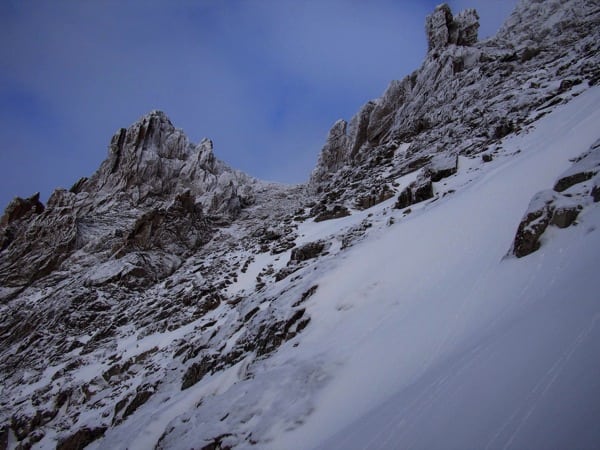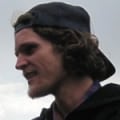In customary fashion, we are off to a late start. Later than usual actually, as it is already pushing 1 p.m. by the time we leave the Nederland grocery store with a pair of cheap cheeseburgers and some overnight foodstuffs. The instant satisfaction of the grease-filled wheat bun eaten on the drive to the trailhead is short lived. We both leave the Brainard Lake parking lot feeling woozy and heavy, a sentiment contrasting with our chosen style for the outing. For a while now, I had been pressing Geoff Roes to hop the Divide for a fast and light overnighter to Lone Eagle Peak. Despite his Alaskan bias, I knew he would appreciate the remote and rugged feel of this place, particularly in the shoulder season. The forecast called for snow and below freezing-temperatures. This excited rather than deterred us, knowing it would keep the crowds at bay and add a stillness and tranquility that only winter can bring.
The seasonal closure of Brainard Lake recreation area adds three miles of paved road to our anticipated nine-mile hike to Crater Lake, which sits below Lone Eagle Peak. I am surprised at the snow accumulation on the road as well as deeper in the forest around us. Granted we are over 10,000 feet, but only 1,500 feet lower at home there was not even a dusting on the ground. As we progress up and over the pass, conditions deteriorate further shifting from a light blanket under foot, to wading, to full on backstroke through the powder on the west side of the Divide.
A break in the flaky, monotone sky reveals Pawnee Lake down below, shimmering in the late-afternoon sunlight. There is not even a breeze, yet the crisp air bites through our gloved hands and stings the exposed skin on our faces.
With the now proper mid-winter like conditions, we start to joke about the lightness of our camping gear. We both have tattered 15-degree sleeping bags that are very far from still holding their temperature ratings. Geoff has a single person tent, while I have a poncho tarp for shelter. We both opted for inflatable torso pads to save space, yet in full winter conditions the foam ones would have been a better choice.
Following the white, near featureless drainage towards the lake, I posthole to my thigh, punching through to a pool of water that rises above my knees. Now I am not only cold, but soaking wet and with the waning light. We decide to stop at Pawnee Lake to camp, some three miles short of our intended destination. We hurry to gather firewood and start to set up camp. In a few minutes, Geoff’s magic touch has the fire blazing. His tent is set-up and he is sharpening a stick to grill a bratwurst. Comparatively, I have accomplished nothing, still fumbling to dig out a pit in the snow to pitch my tarp. I go about searching for an appropriately sized branch to support my structure, which takes several attempts to have me satisfied. I have a love/hate relationship with my tarp. On one hand, it is light, versatile (works as a poncho) and gives me that outside yet sheltered feel you do not get enclosed in a tent. On the other hand, it requires a little effort to pitch correctly, particularly when not carrying trekking poles to use as a frame. I like to bring it along though and find satisfaction in making a good, multifunctional piece of gear work correctly. With the pyramid now erect and completed with my not-so-air-tight inflatable half-mattress, I have a lovely chateau for the night.
Geoff built the fire next to a large boulder that reflects the heat and has us sweating and frequently pulling back hands and feet to not get burned. Steam evaporates from our socks, pants, and gloves as the moisture works its way out of the fabric. We prepare couscous, noodle soup, and tea to accompany the grilled meat. Among other things, we chat extensively about running and wood splitting, which seem to be two of our favorite topics these days. Geoff is a savvy backcountry camper and a good partner to have along. He exudes a certain ease and naturalness through his demeanor that I have rarely seen in anyone. Though understated, the many hours and days spent in the wilds bring out an elegance with which he performs each task around camp, a quality that cannot be learned through a short run in the woods.
I have always liked the idea that I can run and explore a place in a few hours whereas it would take a traditional hiker several days to cover the same distance. While this adds to the quantity of what I can see, it does not necessarily add to the quality of the experience. I have come back to appreciating a slower, longer immersion in wild places as a way to feel my surroundings more fully. A reduction in the amount of gear I bring also allows for a much more direct interaction with place and the opportunity to observe a broader palette of emotions. I seek neither comfort nor suffering, but a rawness in my exchange with place. I feel the wet and cold from the snow, the heat and burn from the fire, the tree roots jabbing under my back during the night, the delight at the glow of the rising sun through the mist. Immersion calluses our being, leading us to be more part of the wild, rather than simply visitors. Despite, or thanks to our lean means, our experience was full and lasting. The more we immerse ourselves in the wild, the closer we come to home.













